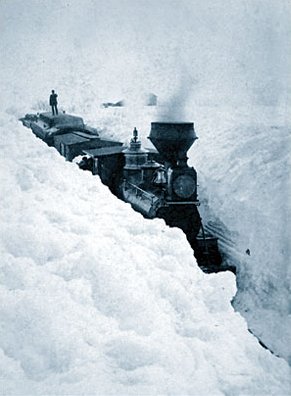Lig dó a bheith ag cur sneachta (wintry weather words in Irish) Posted by róislín on Jan 10, 2015 in Irish Language
(le Róislín)
![An liathróid shneachta is mó ar domhan? Ceann iontach mór é, ar a laghad! (By Kamyar Adl (Flickr) [CC BY 2.0 (http://creativecommons.org/licenses/by/2.0)], via Wikimedia Commons, grianghraf tógtha i South Park, Oxford, Sasana)](https://blogs.transparent.com/irish/wp-content/uploads/sites/17/2015/01/Giant_snowball_Oxford-wikipedia-e1421063708227.jpg)
An liathróid shneachta is mó ar domhan? Ceann iontach mór, ar a laghad! (By Kamyar Adl (Flickr) [CC BY 2.0 (http://creativecommons.org/licenses/by/2.0)], via Wikimedia Commons, grianghraf tógtha i South Park, Oxford, Sasana)
So how’s winter treating you? A lán sneachta? Beagáinín sneachta? Síobthaí sneachta? Ceathanna sneachta?
The key word for today’s blog, as you might have observed, is “sneachta” [SHNAKH-tuh], snow.
So we’ll look at the basic forms of the word and then some related terms.
sneachta, snow
an sneachta, the snow
dlús an tsneachta [… un TNAKH-tuh, silent s], the density of the snow
The plural isn’t probably used all that much (perhaps in favor of phrases like “stoirmeacha sneachta“), but it does exist:
sneachtaí, snows
na sneachtaí, the snows, also: (of) the snows
The one phrase with snow in the plural that comes to mind would be “the snows of yesteryear,” but, snow and behold, the official Irish for that stays singular. I suppose because it’s basically a mass noun to begin with:
sneachta na bliana anuraidh, lit. the snow of the year last year (a little redundant sounding in the literal translation, but not in Irish)
Interestingly, the original French phrase is plural, “Où sont les neiges d’antan?,” as is the Spanish (Dónde están las nieves de antaño?) but I see the German translation remains singular: Wo ist der Schnee vom vergangenen Jahr? Hmm, an interesting consideration as one goes from language to language, but largely beyond our scope here.
And how can we describe snow? Maybe not as many ways as na hIonúitigh might have, but there’s a nice range of vocabulary anyway:

Imdhruidim Shneachta (an bunteideal Béarla: “Snow Blockade”), Traein i Minnesota ar 29 Márta 1881 tar éis síobadh sneachta. An raibh an sneachta riamh chomh hard seo in Éirinn? (fearann poiblí: http://commons.wikimedia.org/wiki/File:Train_stuck_in_snow.jpg, grianghraf ag an Minnesota Historical Society)
síobadh sneachta, a blizzard; including the word “sneachta” is fairly important since we can also have a “síobadh gainimh” (sand-drift) and a “síobadh fearthainne” (driving rain)
cith sneachta, a flurry of snow, lit. a shower of snow; this “cith” [kyih] is the same word that can be use for a “shower of rain” (cith fearthainne) and a shower of hailstones (cith cloch sneachta), as well as other non-weather terms: cith cloch (a shower of stones), cith piléar (a shower of bullets), and cithfholcadh (a shower, for washing)
And some other wintry weather terms:
slush: bogoighear, also means sludge; lit. “soft ice”
(but not for a slush fund, which is a “ciste dubh” (lit. black chest) in Irish
sleet: flichshneachta, lit. wet snow
a snowflake: calóg shneachta
snowflakes: calóga sneachta
frost-bite: dó seaca, lit. frost-burning, not “biting” which would be a bit lengthy, since “to bite” isn’t expressed as a single word in Irish. Some options for “to bite him” are “greim a bhreith air,” “greim fiacla a bhaint as,” “alp a bhaint as” (for a big bite), and “ga a chur ann” (for insect stings),
frost-bitten: siocdhóite or dóite ag an sioc, again, based on “burn,” not “bite”
snowball: liathróid shneachta, with the plural: liathróidí sneachta
snow-drops: plúiríní sneachta
snowman: fear sneachta
snow goose, as immortalized by Paul Gallico, but, hmm, was that a “greater snow goose” (mórghé shneachta), or, a “lesser snow goose,” which, logically enough, is “mionghé shneachta.” I suppose if I went back and watched the TV version (1971, with Richard Harris and Jenny Agutter), which I haven’t seen for years, I might be able to tell. Or maybe Gallico specifies. Have to check the original book. If you’re not familiar with Gallico’s Snow Goose, you might want to check it out. It’s short, evocative, and sentimental, and was part of the inspiration for Michael Morpurgo’s War Horse. And for Camel’s aptly named 1975 album Music Inspired by The Snow Goose. Ar léigh tú an leabhar? Nó an bhfaca tú an clár teilifíse? Nó ar chuala tú ceol Camel atá bunaithe ar an scéal? Céard a shíl tú faoi?
snow globe: cruinneog shneachta
snow tire: bonn sneachta
snowy: sneachtúil
a snowy owl or “harfang” (hmm, so that’s where C. S. Lewis got the word in his The Silver Chair): ulchabhán sneachtúil
Well, hopefully that’s some interesting vocabulary, but not so much that you feel “snowed under” (go dtí an dá shúil i bhfocail nua). Slán go fóill – Róislín

Build vocabulary, practice pronunciation, and more with Transparent Language Online. Available anytime, anywhere, on any device.




Leave a comment: